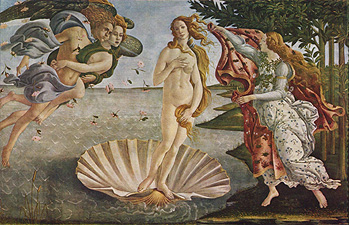
"The birth of Venus" (Botticelli, 1482). Enlarge view! Picture: Wikipedia.
 "The birth of Venus" (Botticelli, 1482). Enlarge view! Picture: Wikipedia. |
The painter Alessandro Botticelli (1446 - 1510) is estimated one of the leading representatives of the Florentine Renaissance. His name either is from his brother or from his first employer, who was called Botticello (little barrel).
From 1470 Botticelli worked in his own shop. For nearly all of his life Botticelli painted for the rich and mighty of Florence. Among his clients were the famous family of the Medici, who he painted numerous portraits, but also several other pictures, that can be found today in the Galleria dei Uffici in Florence.
Botticelli's time is characterized by the awakening of classical motives in art. "The Birth of the Venus" is a good example, as it shows a motive from the classical Greek mythology, but it has a content of contemporary Christian philosophy - beauty is of God's making.
According to the Greek myth Aphrodite (or Venus, as is her Roman name) was born when the titan Chronos ("the time") castrated Uranus, his father, whose severed genitals fell into the sea and fertilised it. Aphrodite was born from the foam and was taken ashore by a giant cockle at Paphos on Cyprus in the Eastern Mediterranean.
While the nymphs and wind gods displayed around the Greek goddess of beauty and love have their own meaning in the painting (see additional information below), to the person interested in molluscs besides it is interesting, that not a Venus clam takes Venus ashore, but a large cockle, possibly a large prickly cockle (Acanthocardia aculeata). Though, the spiny cockle, as does the Venus clam, only reaches about 8 cm in size and so is much smaller than the cockle displayed in the painting, except Botticelli's Venus would have been only 10 cm tall...